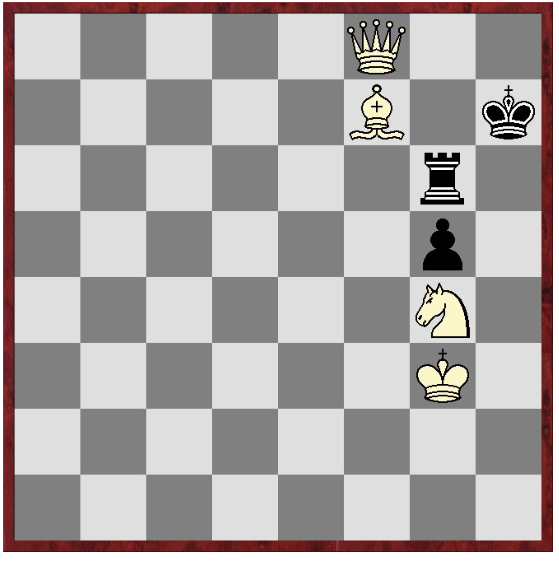There are only two rules for this
exercise.
First,
and most importantly.NO BOARDS or chess
visual aids! Second, when entering the move, you will
simply denote moves by short algebraic (e.g., e4, c5, Nf3 etc.). If there is a piece capture, you will use a small "x" instead of any
other symbol. There is no time limit for this exercise. Enjoy!
1. After the moves 1.e4 e5 2.Qh5 Ke7, what is white's best
move here?
2. After the moves 1.c3 e6 2.Nf3 Nc6 3.Nd4 Ne5 4.e4 c6 5.Nde2,
what should black play here?
3. After the moves 1.e4 f5 2.exf5 Nc6 3.Qh5+ g6 4.fxg6 Nf6,
what is white's best move?
4. After the moves 1.e4 e5 2.Nf3 f5 3.exf5 Kf7 4.Nxe5+ Kf6
5.d4 Kxf5 6.Qg4+ Kf6, what
should white play here?
5. After the moves 1.g4 d5 2.Bg2 Bxg4 3.c4 c6 4.Qb3 Qc8 5.cxd5
cxd5 6.Bxd5, what
should black play here?
6. After the moves 1.e4 Nf6 2.e5 Nd5 3.c4 Nb6 4.d4 Nc6 5.d5
Nb4, what should white play here?
7. After the moves 1.g3 g6 2.Bg2 Bg7 3.e4 c5 4.d3 Nc6 5.c3 d6
6.Be3 Qb6 7.Qd2 Ne5 8.Na3,
what should black play here?
8. After the moves 1.d4 Nf6 2.c4 e5 3.dxe5 Ng4 4.Nf3 Qe7 5.Bf4
Qb4+ 6.Bd2 Qxb2 7.Bc3,
what should black play here?
9. After the moves 1.e4 c5 2.Nf3 Nc6 3.d4 cxd4 4.Nxd4 Nf6
5.Nc3 d6 6.Bc4 g6 7.Nxc6 bxc6
8.e5 dxe5, what should white play here?
10. After the moves 1.d4 Nf6 2.c4 c5 3.d5 b5 4.cxb5 a6 5.Nc3
axb5 6.e4 b4 7.Nb5 Nxe4,
what should white play here?
11. After the moves 1.e4 c5 2.Nf3 Nc6 3.d4 cxd4 4.Nxd4 e5
5.Nb5 d6 6.c4 Nf6 7.N1c3 a6 8.Na3,
white is holding the d5 square
how many times? (type the number)
12. After the moves 1.d4 Nf6 2.c4 c5 3.d5 b5 4.cxb5 a6 5.f3 e6
6.e4 c4,
white can capture how many different pawns? (type the number)
13. White has a pawn on e6 and a king on d5. Black has a pawn
on d6 and a king on c8.
It's white to move, so what should he/she play?
14. White has a king on h2 and a knight e1. Black has a king
on d5, a knight on e5,
and a pawn on c3. It's black to move, so what should he/she play?
15. White has a king on a8, a queen on b2, and a pawn on b7 -
threatening to queen.
Black has a king on c7 and a queen on h1 - pinning the pawn. It's
white to move,
so what should he/she play?
|
||||||
